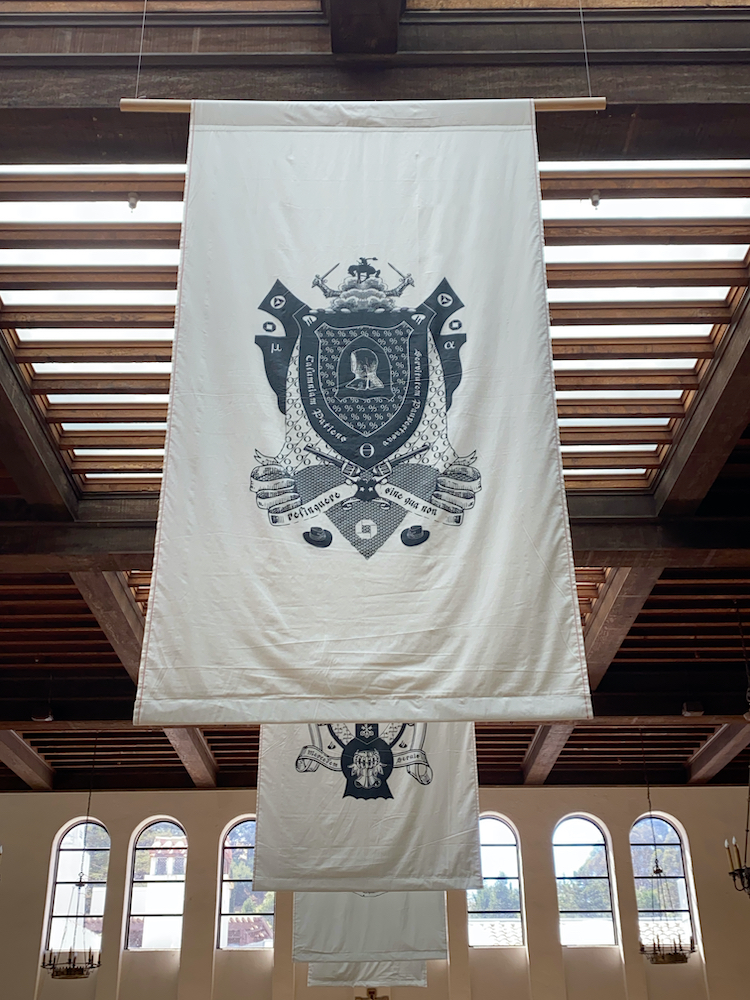We Are Market Makers (2017-9)
These artworks are a lamination of symbolic forms that mimic the aesthetic norms of an heraldic symbolic arrangement. Historically, shields and flags bore escutcheon that were often designed to represent massive wealth accumulation and used by a hired (mercenary) army to protect it. Any family that had a legitimate claim to order a crest chose symbols and colors specific to them (by their region or landmarks, by animals or weapons, etc). Once designed, the escutcheon and details are used consistently across applications, much as logos are today. Materials used in their fabrication changed to align with any particular use. Ceremonial events employed family symbols within highly ornate objects that refer to other uses of the same visual lexicon. A prince’s helmet or armor, for example, would be made of a precious metal to be used in the context of the royal court and therefore rendered useless for battle, but it efficiently connotes the violence with which the wealth used to make that very amour has been gained. It is both a celebration and a warning. Soldiers marched and fought under family banners that helped them identify each other and their enemy in battle. The visual heraldic forms of escutcheon, banners, and symbols amalgamate to produce a universally legible signifier that is available to a range of uses.










The symbology used on these artworks represents a range of correlating forms and meanings. Each item on the visual field of the escutcheon is called a charge. The charges in my work include heraldic forms (banners, shields, motto, animals and figures), cowboy imagery (hats, guns, cowboys, horses), bank logos and latterly, portraits of contemporary individuals tied to the creation and propagation of debt.
I am using the escutcheon in the historical mode, as a ‘frame’ populated by several registers, or charges of symbolic imagery such as Greek glyphs, heroic cowboy imagery, bank logos, bank mottos, contextual text (the names of the work themselves). Each layer of symbolism brings another dimension of particularized meaning. Greek glyphs are applied using their repurposed definitions found in finance mathematics. The terminology of the re-purposed glyphs includes language that both defines the activity of its use in finance and somewhat reflects terms or ideas used in art theory. To give an example, Δ (delta) = the symmetric difference; θ (theta) = the unknown parameter. The particular (finance math) definition is embedded where Δ or θ are placed on the visual field, and naturally connect to adjacent charges. It is important to stress, however that the combinations one may find in the images are not meant to narrate, but rather create zones of intensity that motivate the attraction of the viewers’ gaze, through which an individual reading is attained.
I use bank logos as contemporary signifiers in historical parallel with heraldic forms and cowboy imagery. The hats, guns, cowboys, horses connote a part of American history that has metamorphosized to a largely mythical cultural phenomena that persists to this day. In many ways, the violence in the representation of this era of America history is the root of its celebration in popular cultural forms. When exposed to those popular cultural forms, one may also witness zones of intensity similar to that aim to provoke the possibility of remembering. The cowboy images present a strong identification with the notion of an unregulated terrain – a free zone, a zone above and beyond the law. This proposes an overlap where lawlessness or perhaps an heroic flouting of law reflects the activity of finance within the environment of deregulation. ‘White collar crime’ for example can be directly pinned to the self-elected autonomy and antisocial status of the cowboy (strongly expressed in John Ford’s representations such as John Wayne’s Ethan character in The Searchers). A major point of difference is that in the cowboy myth, the bad actors are always held to account by the conquering sheriff or bounty hunter.
The extent of control that debt and finance have over literally every aspect of society cannot be overstated. Debt is ubiquitous. When examining any product (including intangible experiences), it is easy to trace the points where debt has enabled the creation of products; it is the transactional vehicles of capital. In this way, finance continually extracts wealth through an array of constantly morphing forms of debt collection through the usage of its function. It is so pervasive that debt forms an associated penury, and in these artworks, I am directly addressing the lineage and contemporary effects of debt and finance, the creation of obscene wealth and concentrated power gained historically through violence that is celebrated through popular media and exists today in more insidious forms that no longer need to enact physical violence Debt and finance can instead enforce a new type of violence through the seductive faces of mass consumption. The early usage of heraldic messaging and what it has meant has moved on so successfully from direct violence that we have necessarily become complicit in our own demise in order to meet our basic needs.
Original Drawings






